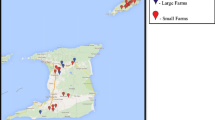Summary
A survey of 558 pigs for serological evidence of infection with Japanese encephalitis virus (JEV) performed during the summer of 1968 is recorded. Antibodies were detected by the goose red cell haemagglutination-inhibition test. A high incidence of infection was recorded among mature stock in the New Territories (75·4 per cent) with lower degrees of infection on Hong Kong Island (35·8 per cent) and in Kowloon (26·5 per cent). Of 57 pigs under one year of age only four showed evidence of infection.
In view of the widely recorded incidence of JEV in Asia, its occurrence in Hong Kong was to be expected. The regional variation in level of infection within the Colony is probably due to differences in terrain and agricultural development, with consequent differences in availability of mosquito breeding sites. It is concluded that JEV is probably a significant pathogen of pigs and humans in the Colony.
Résumé
Une enquête sérologique pour mettre en évidence l'infection par le virus de l'encéphalite japonaise a été effectuée sur 558 porcs pendant l'été de 1968. Les anticorps furent recherchés au moyen du test d'inhibition de l'hémagglutination des hématies d'oies. Un très haut taux d'infection fut signalé chez les porcs adultes des New Territories (75, 4 per cent) avec des degrés d'infection plus bas dans l'ile de Hong Kong (35,8 per cent) et dans Kowloon (26,5 per cent). Sur 57 porcs âgés de moins d'un an, seulement 4 se révélèrent infectés.
Etant donné la très large distribution du virus de l'encéphalite japonaise en Asie, on pouvait s'attendre à le retrouver à Hong Kong. Les différences régionales dans les taux d'infection à l'intérieur de la colonie sont probablement dûes aux différences de terrain et de degré de développement agricole, avec pour conséquence, des différences de possibilités de multiplication des moustiques. On en conclut que le virus de l'encéphalite japonaise est probablement un agent pathogène important pour les hommes et les porcs de la colonie.
Resumen
Se registra un estudio serológico de 558 cerdos para poner de manifiesto la infección con el virus de encefalitis japonesa (VEJ) llevado a cabo durante el verano de 1968. Fueron descubiertos anticuerpos por medio de la prueba de inhibición de la hemoaglutinación usando glóbulos rojos de ganso. Se registró alta incidencia de la infección entre los cerdos adultos en los Territorios Nuevos (75.4 por ciento) con niveles más bajos en la isla de Hong Kong (35.8 por ciento) y en Kowloon (26.5 por ciento). De 57 cerdos menores de un año solamente 4 mostraron evidencia de infección.
En vista de la vasta incidencia registrada del VEJ en el Asia, su presencia en Hong Kong era de esperarse. La variación del nivel de infección dentro de la Colonia se debe probablemente a las diferencias en el campo, en el ambiente, y en el desarrollo agrícola con diferencias consecuentes en la disponibilidad de áreas favorables para la crianza del mosquito. Se concluye que el VEJ es probablemente un patógeno de significación para cerdos y humanos en la Colonia.
Similar content being viewed by others
References
Annual Departmental Reports, 1967–68. Director of Agriculture and Fisheries, Hong Kong Government, Government Printer, Government Press, Hong Kong, p. 109, appendix 4.
Annual Departmental Reports, 1967–68. Director of Medical and Health Services, Hong Kong Government, Government Printer, Government Press, Hong Kong, p. 23, para. 75.
Clarke, D. H. &Casals, J. (1958). ‘Techniques for hemagglutination and hemagglutination-inhibition with arthropod-borne viruses’.American Journal of Tropical Medicine and Hygiene,7, 561–573.
Hoskins, J. M. (1967).Virological Procedures. London: Butterworths.
Kawakubo, A. (1961). ‘Neutralising antibodies in pig serum against Japanese B encephalitis’.Bulletin of the Azabu Veterinary College, Japan, no. 9, 185–195.
Mackie, J. B. (1964). ‘A Guide to the Species of Culicenes which give rise to Domestic Mosquito Nuisance in the Colony of Hong Kong with notes concerning them’. Government Printer, Government Press, Hong Kong, 1964 reprint, p. 14.
Morimoto, T. (1968). ‘Epizootic Stillbirth Caused by Japanese Encephalitis Virus’.Journal of the American Veterinary Medical Association,152, 40.
Scherer, W. F., Moyer, J. T. &Izumi, T. (1959). ‘Immunologic Studies of Japanese Encephalitis Virus in Japan. V. Maternal Antibodies, Antibody Responses and Viraemia following Infection of Swine’.Journal of Immunology,83, 620–626.
Shimizu, T., Kawakami, Y., Fukuhara, S. &Matsumoto, M. (1955). ‘Experimental still birth in pregnant swine infected with Japanese encephalitis virus’.Experimental Report of the National Institute of Animal Health, Tokyo, no. 30, 53–66.
Author information
Authors and Affiliations
Rights and permissions
About this article
Cite this article
Higgins, D.A. A serological survey of pigs in Hong Kong for antibodies to Japanese encephalitis virus. Trop Anim Health Prod 2, 23–27 (1970). https://doi.org/10.1007/BF02359325
Accepted:
Issue Date:
DOI: https://doi.org/10.1007/BF02359325




